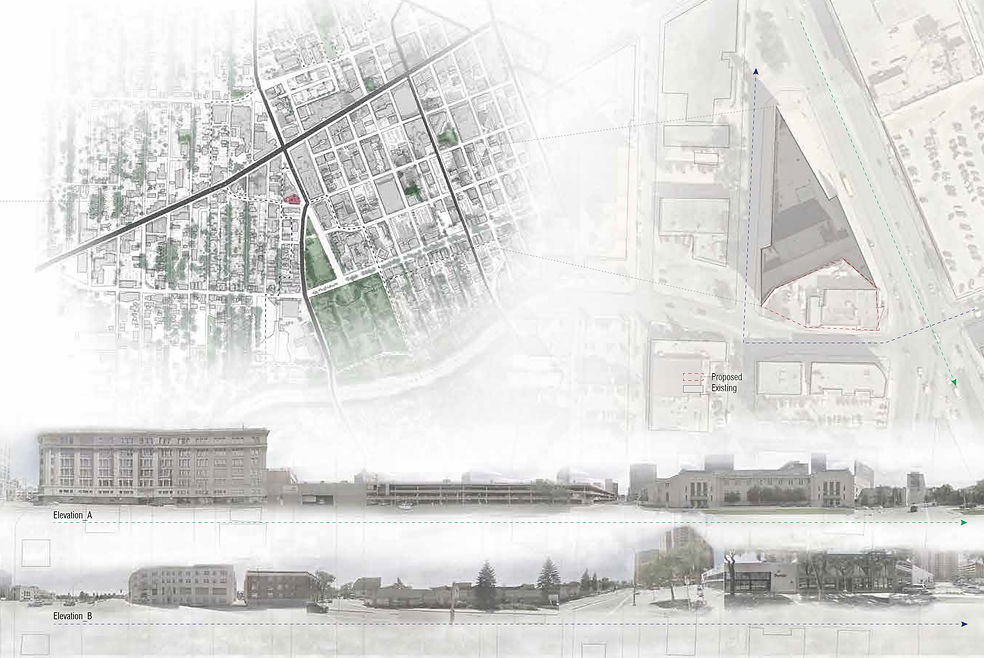
WAG ADDITION + LEARNING CENTER
UTSOA | Program: Museum Addition
Winnipeg, Canada | Vince Snyder | Fall 2016
Collaboration with Yoko Shimajuko
“The rhythm of the seasonal cycle is deeply imprinted in the Inuit culture.”
--Eric Loring, Canadian Heritage Information Network
Long before Herbert Spencer’s idiom “Survival of the Fittest,” the Inuits were the epitome of surviving in harsh and unforgiving climates. The Inuits didn’t fear the cold; they took advantage of it. Geography played a huge role in the development of the Inuit culture and lifestyle. Seasonal changes in the migration patterns of their prey determined their temporary location. Consequently, this produced a nomadic cyclical procession between summer and winter quarters. The Inuits migrated south from their homes in the Arctic due to a period of much colder weather which drove herds of whales and seal south. In the summer, the Inuits would travel to northern lands in search of caribou. As a result, the Inuits would travel in a cyclical fashion around the Arctic North, ranging from Alaska to Canada to Greenland to Russia. Furthermore, the current issue of global warming has affected the Inuit’s natural habitat. The climate change has also contributed to the nomadic procession of the Inuits. An international non-government organization called the Inuit Circumpolar Conference seeks to protect the interests and rights of the Inuits and raise awareness of global warming. For the Inuits, alleviating climate change has become an issue of cultural survival.



Mapping of Procession
Inuits across Canada’s arctic shared similar aspects of culture but had regional differences. As a result of their nomadic processions, the Inuit’s art evolved from the indigenous characteristics of each region they visited. For example, the Mackenzie Inuit tribe located northeast near Alaska had an abundant supply of wood while the Copper Inuit made use of the natural copper deposit in their region. Furthermore, a series of in-depth analyses of the Inuit culture, customs, traditions, and movement were implemented. A direct correlation was made between the Inuit’s travels across the arctic with respect to natural factors, such as climate change and glacier retreats. The cyclical procession of the Inuits travelling between different regions derived the concept of the Winnipeg Art Gallery addition. As one enters the addition, the guest is directed through a series of ramped paths ultimately leading the observer through multiple levels, which extend either into a temporary exhibition, permanent exhibition, or studio space. The gallery extension of these pathways will be dedicated to the art of the different tribes of the Inuits. As the observer travels throughout the building, he or she is constantly revolving around the vitrium, a vertical expansion of glass which displays different Inuit artifacts. The idea is to create awareness in the observer of his or her procession throughout the building relative to the Inuit’s nomadic cultural lifestyle while having the art reinforce one’s experience.

Studies in procession, hierarchy, and solid [program] vs void [circulation]

First Floor
Second Floor
Third Floor

Entrance Perspective

Winter Garden
The Sacred Artifact
Often times when the Inuits traveled they brought along their artifacts. Because of their nomadic lifestyle, these artifacts had to be relatively small. When one told a story about their artifact, one would simply take it out, unwrap it from its protective covering, tell the narrative, wrap it back up and store it away safely. Having that concept transcend into the architecture of this addition, a primary location or the hanging jewel of the building becomes the main storage of artifacts. The storage of artifacts, in this sense becomes celebrated and is suspended above the viewer allowing one to experience the exhibition from multiple levels. Within this enclosed space are movable armatures, holding different artifacts that are showcased at different times of the year.